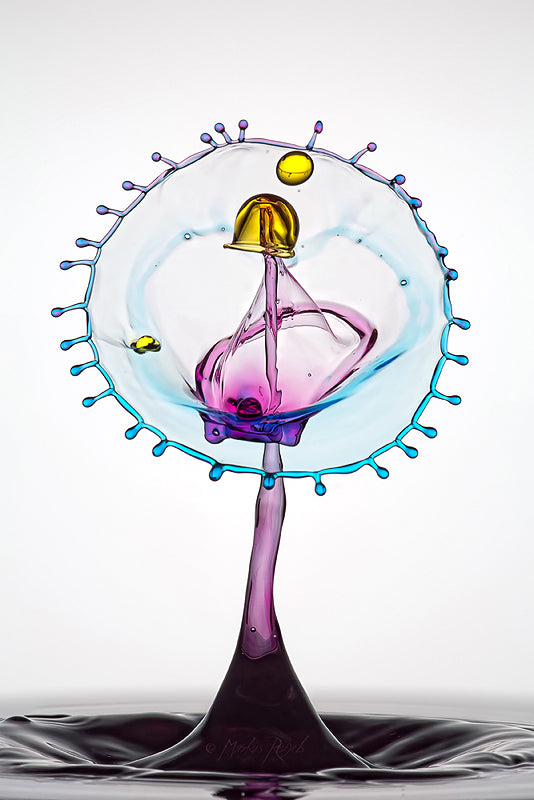Markus Reugels is a macro photographer from a small village near Schweinfurt, Germany. He started photographing only three years ago, but has progressed rapidly in the field of macrophotography and in photographing droplet photography, specifically. We asked him to give us some background in how he has been setting up for his magnificent shots.
THE DROP ON DROP TECHNIQUE
"The basic "drop on drop" technique works with two drops. The first drop falls into the water and forms a crater, then a crown, and finally a column. The second drop must be timed so that it lands on the column. The collision then forms the varying shapes such as mushrooms, hats, or flying discs. When the distance between the first and the second drop is prolonged, the shapes can change even further. When the distance is shortened, the shapes turn more into hat-like structures. At a rate of ten drops per second, mushroom shapes are common. At fifteen drops per second, flying shapes form, and with six drops per second, the hat-like shapes appear. To get smooth shapes with fewer water droplets around them, i increase the viscosity with guar gum. It´s more work to mix the water and filter the grain out, but the results are worth the extra work.
STARTING OUT
"A few tips will help you get started making excellent water droplet images. You can start with a simple bag with a small hole, a tripod, and a remote trigger. The best way to light the droplets is through an external flash which can be regulated manually. You must set the power of the flash lower than 1/16 to get sharp pictures. With such settings, the flash duration is higher than 1/16,000. This is the reason why the shutter speed is less important in this situation. The action in high speed photography is frozen by the light and not by the shutter. A good hint is to catch the falling drops into a cup and release the drops into the tray by moving the cup out of the way. This way, you have a calm water surface, and you can control the timing of the shutter release better than just relying on luck.
NEW TECHNIQUE - DOUBLE PILLARS
"I have found a way to produce extra large splashes. They are very popular, and many water droplet photographers worldwide produce them. I have discovered a new technique with the drops, which I call the "Double Pillar." On top of two pillars, I place a third drop to achieve a shape as well.
INCREASING VISCOSITY OF THE DROPS
"Normally, I thicken my water with guar gum to increase the viscosity (thickness). I want a similar viscosity to milk or cream. This helps to make smoother shapes, and they hold longer together before they collapse. Sometimes, I use only milk, as I find this is the best fluid for the droplets. You can bring color into the water droplet pictures without coloring the water. With milk you can bring color into the splash with the light, so you must only use gels on the flashes. Check out a light setup here.
EQUIPMENT FOR SHOOTING DROPLETS
"I use a Sony alpha-700 with a Minolta 100 mm f/2.8 Macro lens. For flashes, I use only the old Vivitar 285 with a little modification. I set the power lower than 1/16. As timing device, I use a homemade device called "GlimpseCatcher." [We have to give props to the people using or inventing their own devices.] I usually use a small aperture such as f/16. I find this is the best compromise between sharpness and diffraction blur. The shutter speed is not important in high-speed photography, as the action is frozen by the light from the flashes. The flashes have a flash duration fasten than 1/16,000 at low power settings. No camera has a shutter faster than the light from the flashes. I usually choose 1/160th of a second for shutter speed. My ISO settings are usually between 160-320, depending on how dark the gels are that I am using or what type of lighting I am using for the shot."
Stay connected to Markus: Website | Flickr | Facebook
RELATED ARTICLES
How I Got That Shot - Jennifer Wu
Ace Kvale Photographing for the Himalayan Cataract Project
Seth Casteel's Underwater Dog Photography




